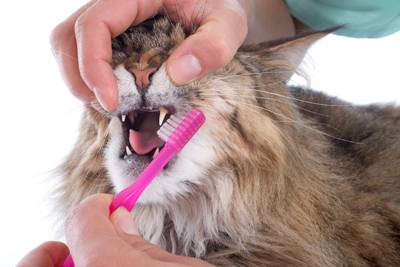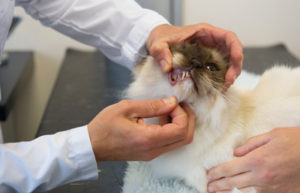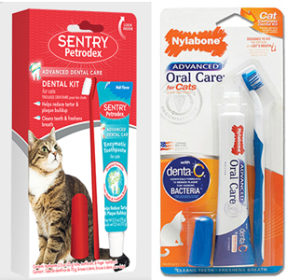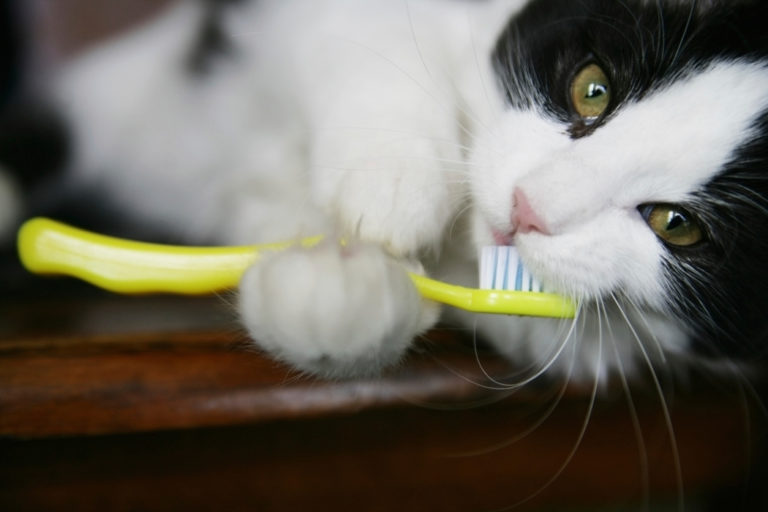Healthy teeth and gums are essential to your cat’s well-being.
Most of us wouldn’t think of leaving the house in the morning without first brushing our teeth—yet we might regularly neglect the oral hygiene of our feline friends. Over time, if left unchecked, bacteria can build up in a cat’s mouth, causing plaque to form on the teeth. This plaque eventually hardens and calcifies into tartar, and more bacteria accumulate.

This process often results in inflammation of the cat’s gums and can even lead to periodontal disease. How do you know if your cat has issues with his teeth? Here are some common symptoms:
- Bad breath
- Bleeding in the mouth or from the nose
- Discolored teeth
- Weight loss or change in appetite
Also take note if your cat does any of the following:
- Drops food while eating
- Chews on only one side of his mouth
- Paws at his mouth
- Grinds his teeth
Still, your cat might show no outside symptoms of dental disease. For this reason, veterinarians recommend regular dental evaluations to allow for a thorough check of the cat’s mouth and gums. During this evaluation, your cat will be anesthetized so the vet can perform a dental charting, periodontal probing and intraoral X-rays. Dental charts allow your vet to record the position and condition of each tooth, so the tooth’s condition can be tracked over time. Periodontal probing is the process in which the vet gently probes the gums in the cat’s mouth to check for tooth resorption.

Your vet might also ask to perform a dental cleaning while your cat is anesthetized. During the cleaning, the vet will “scale” the plaque and tartar buildup from your cat’s teeth and polish the teeth, much like your dentist would do at your teeth cleaning appointment. The vet also may surgically extract any diseased or damaged teeth at this time.
You can help prevent dental disease in your cat by practicing regular feline dental care at home. Obviously, most cats may initially resist having someone try to brush their teeth. And while this process should ideally begin when your cat is a kitten, you can begin working with your cat at any age of his life.
First, make sure you have the correct supplies: cotton swabs, a small feline toothbrush with soft bristles and toothpaste formulated for cats (don’t use human toothpaste!). Next, introduce your cat to the process by following these steps:

- Hold your cat quietly in your lap, and stroke him. You want your cat to feel safe and comfortable.
- Gently massage his gums with your fingers. Try touching a cotton swab to the gums.
- Repeat these steps for a few sessions, being sure your cat is content and comfortable throughout each session. You want your cat to associate dental care with pleasant experiences.
- After a few sessions, put a bit of the feline toothpaste on your cat’s gums so he can taste it.
- At the next session, introduce a toothbrush designed especially for cats. Let your cat chew on it and play with it, then gently pass it over his teeth. You can also use a soft feline toothbrush-type finger cap that slides over your finger.
- When your cat seems used to the toothbrush, place a bit of toothpaste on the bristles and gently brush his teeth.
As with humans, brushing teeth needs to be part of your cat’s routine. Ideally, you should brush your cat’s teeth every day. Make it part of a regular petting or grooming session, and soon your cat will think of the activity as another pleasant experience (or least a not unpleasant one). And you’ll enjoy helping your cat avoid dental problems.
About the Author: Stacy N. Hackett is an award-winning writer with more than 25 years’ experience in the pet industry. She is the former editor of Pet Product News and a former staff editor with Cat Fancy, Cats USA, Critters USA and Ferrets USA. To learn more about her work, visit stacynhackett.vpweb.com.







